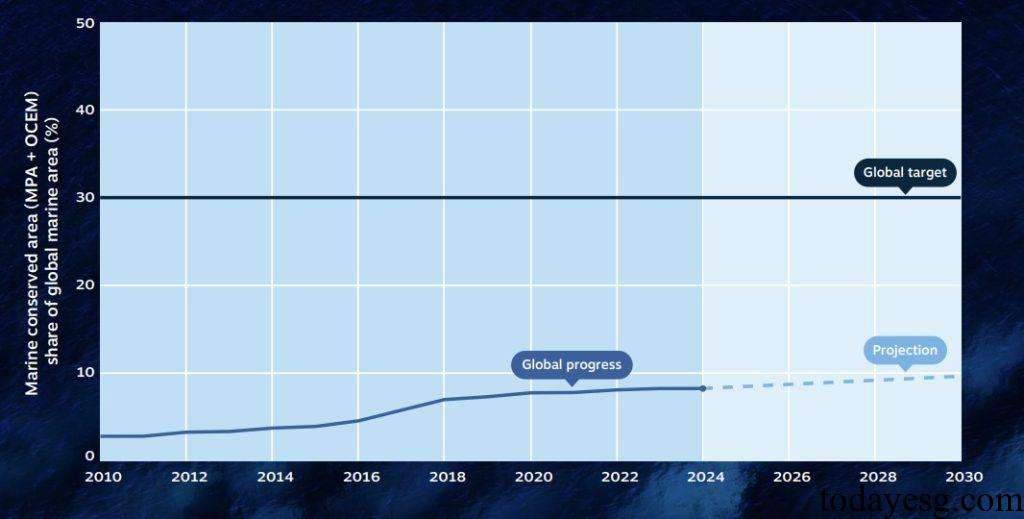Global Ocean Conservation Report
Bloomberg released the global ocean conservation report aimed at analyzing the differences between the current state of ocean conservation and the ocean conservation goals set by the Global Biodiversity Framework and providing relevant recommendations.
The global biodiversity framework adopted at COP15 proposes to protect 30% of the world’s land and oceans by 2030 to address the dual challenges of climate change and biodiversity. Protecting marine ecosystems can help humans maintain key resources such as food supply, climate regulation, and carbon capture, ensuring sustainable development.
Related Post: EU Announces Largest Ocean Governance Commitments
Current Status of Global Ocean Conservation
Ocean conservation typically consists of two parts, namely Marine Protected Areas (MPA) and Other Effective Area based Conservation Measures (OECM). Marine Protected Areas refer to areas where the ocean is regulated and actively managed to ensure minimal or no destructive activities such as industrial fishing and mining. Other Effective Area based Conservation Measures refer to geographical locations that provide long-term protection under fair governance and management.
Bloomberg finds that the current progress in global ocean conservation is far below the scale and speed required to achieve the 2030 goals. As of August 2024, only 8.3% of the world’s oceans are protected, with only 2.8% receiving comprehensive protection. Since the introduction of the Global Biodiversity Framework in 2022, the proportion of ocean conservation has increased by a total of 0.5%. Based on this rate of development, only 9.7% of the world’s oceans will be protected by 2030, which is below the target of 30%.
The proportion of ocean protection varies greatly in different regions of the world, with the lowest coverage in the high seas (1.4%) and the highest coverage in Latin America (26.6%). These proportion differences may come from the geographical location of the country or the number of resources it invests. At COP16, countries will submit their National Biodiversity Strategies and Action Plans, which will include plans for ocean conservation. Currently, only one-third of the 156 coastal countries worldwide have agreed to the 2030 protection goal.

How to Achieve Global Ocean Conservation Goal
Bloomberg believes that action needs to be taken globally in terms of coverage and effectiveness of ocean conservation to achieve ocean conservation goal. These actions include:
- Increase the coverage of national and international marine protected areas and set national conservation goals: Currently, only 14 coastal countries have marine protected area coverage exceeding 30%. Countries need to consider increasing their commitments and actions within national waters, ensuring good marine spatial planning, and recording these goals in international biodiversity strategies and action plans. For the protection of the high seas, countries should ratify the High Seas Treaty as soon as possible, provide a legal framework for high seas protection, and take action to protect high seas marine protected areas such as Antarctica.
- Improve the quality of marine protection and achieve effective protection: It is not enough to measure whether the 30% protection target has been achieved solely based on the legal status of marine protected areas. Effective marine protection also includes reducing the impact of harmful activities. Countries should use the MPA Guide to develop planning, assessment, and calculation processes, increase the number of actively managed and highly protected marine protected areas, and report the protection level of each marine protected area in international databases.
- Support Indigenous Peoples and Local Areas: Indigenous peoples manage over 40% of the world’s ecosystems, and countries needs to consider establishing Indigenous Protected Areas to support the establishment of local ocean conservation management mechanisms and reduce conflicts of interest. Countries can consider combining the traditional knowledge of indigenous peoples with scientific research as a supplementary source of information for ecosystem management, providing financial support and alternative sources of income for indigenous peoples.
- Release sufficient and sustainable international financing: Currently, countries invest $68 billion annually in biodiversity, and they plan to increase the funding scale to $200 billion by 2030. Therefore, the world needs to increase public financial investment and reduce funds that are harmful to marine conservation. In addition, multilateral governance frameworks need to provide more funding to developing countries to help them manage biodiversity risks through grants and preferential loans.
- Improve information disclosure and data collection: Countries need to consider adopting standardized mechanisms for collecting and reporting data on marine protected areas, allowing stakeholders to track future conservation progress.
Reference:









